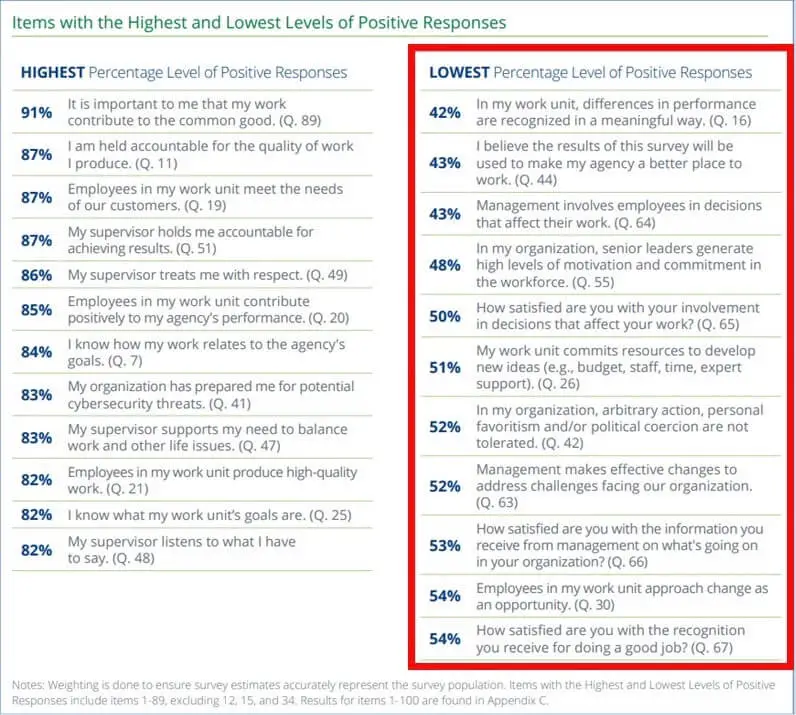I am fairly confident that in this article I am wading into some treacherous water in talking about leadership, however, based on the 2022 Federal Employee Viewpoint Survey results, and the number of leadership related issues that are included with the Lowest Percentage of Agreement items that I have highlighted below, I think it extraordinarily relevant and important to talk about. We could discuss the obstacles and demands of leadership, however, based on these results and the hundreds of thousands of individuals (civilian and military) who participated in this survey, leadership is a continuing, pervasive, and ongoing challenge. We can’t just ignore it.
From the 2022 Governmentwide Management Report based on 2022 FEVS results:
“High scores below point to favorable employee perspectives regarding agency practices and policies. Equally important, however, are items with low scores indicating aspects of Federal government agencies where employees may perceive the need for change. Government leaders and oversight bodies review low scores to make decisions and determine actions for improving workplace functions and conditions (e.g., items related to performance and communication)”
Don’t Leave Leadership to Chance
Our staff members show up to work every day with some expectation that they are there to work, though in far too many cases we are leaving this to an optimistic hope. If we, as leaders, are not taking the time to inform our team members what we are looking for and what our expectations are for performance, we are handing off our responsibility and leaving the outcome to chance.
In the absence of leadership, human beings will wander where they will, doing whatever they feel like doing. No more than a parent can blame his or her child for wandering off when turned loose at a playground, we cannot blame our team members if we turn them loose on our organization without some understanding of what we expect of them.
It’s Not All About You
The Army defines leadership as “the process of influencing people by providing purpose, direction, and motivation while operating to accomplish the mission and improve the organization”. The one thing it is not about is you, and it is only peripherally about your positional authority. Leadership is all about your effective influence over your assigned staff members in successfully completing the tasks, projects and other activities assigned to you. Your being senior or the most experienced or the most skilled has little to do with it. Though the reality is, as leaders we will occasionally fail, failure is not an available option for leaders. When we fail as leaders, it is our approach to leadership that has failed.
I know that leadership is not a comfortable fit for many of us, but the reality is that in any human endeavor, if there is an expectation of movement, activities, or actions to be taken, there needs to be somebody to take on the role and responsibility for making those things happen. That is the role of the leader and teams can end up lost and directionless without it.
Conversely, once our team members are given direction and guidance in their activities and actions, we will find them going (mostly) where we need them to go, doing (mostly) the things we need them to do. Once our people begin to see us as the leader, as that provider of direction and guidance, as their boss if you will, they suddenly and miraculously become better, more willing followers and weird things start happening. Morale goes up, productivity begins to improve, and expectations are generally met.
Being specific in what we want from our people makes it discernibly clear as to what our expectations are, though this only matters if we go beyond our words and by our actions reinforce and support those first tentative steps toward accomplishment. Our words, as leaders, allow us to demonstrate our willingness to talk the talk of change and heightened expectations. Our actions, dedicating time, resources, and effort to our journey, shows we, as leaders, are willing to walk that walk.
Praise is Crucial
Did I forget to mention that if our people do the things we ask of them in this journey toward accomplishment, we must address it with them when they screw-up and praise the heck out of them when they succeed? This is especially important and one of the most demotivating ways in which we fail as leaders.
People, our team members in other words, want to know that they matter, want to know that we notice what they are doing and know that they contribute to our success. If we are only there to tell them when they screw-up, then growth and being successful will appear to be less important to them than it should. I promise lightning won’t strike if you compliment the efforts of your team members, and you just might find that they will work harder for that acknowledgement and that approval. If you are not careful, you just might find your team accomplishing all the things you ask of them. How cool and pleasantly rewarding would that be?
Where Can You Begin?
Don’t know where to start on this journey from good to great? Dig into those FEVS results for your organization. It will not have all the answers but is a great place to start.
If it says your senior leadership has issues with integrity or honesty, work to understand what is driving that perception and be visible fixing it. If there are concerns with how we manage high performers versus low performers, a common concern, fix it and be seen fixing it.
Surveys like FEVS are a panoramic view of you, as a leader and your organization. How will FEVS present you and your organization this year? What can we do to assure that view for next year?
Leadership is providing that purpose, direction, and motivation to accomplish the mission while improving your organization. Where they go and what they do is up to you.




